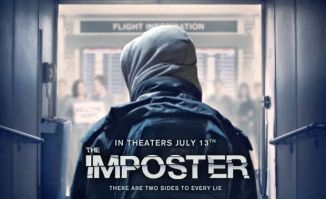Unit 22 – Task 3
Cinematography
This scene features many techniques of cinematography, it begins with what looks like a simple panning shot from the right of the room, to the left, ending with Skylar framed in the left of the shot with nothing else in the frame, its a simple shot framed used the rule of thirds with Skylar in the left third. The scene progresses onto a mid shot and close up of Skylar on the phone talking to Marie, this follows a standard shot reverse shot rule, almost with them looking like they are having a conversation with them in person. Finally there is a dolly tracking shot moving forward to reveal Walter standing in the room with Skylar the whole time, this technique is done to dramatically reveal his presence in the room.
Mise en Scene
The mise en scene in this scene consists of low-key lighting, showing the tone of the scene, with Skylar now living in a dingy small apartment, with what looks like run down and old looking appliances mirroring her own financial and personal situation at this point in the tv series. The lighting in the moment of Walters big reveal is very contrasting, Skylar is in darkness and Walter is in the light, perhaps showing the revealing nature of the scene.
Sound
The sound in the scene starts with a diegetic noise coming from the telephone within the room of the scene. This helps to build suspense within the audience, wondering who Skylar will be talking too. The next sound comes in the form of Marie talking to Skylar via the answer machine. There is some atmospheric background noise coming from outside the apartment, a dog barking, this helps add to the atmosphere of the scene and perhaps makes the audience realise that Walter got into the flat without being seen. Finally the last sound in the scene comes from Skylar and Walter themselves as they begin talking to one another. The lack of non diegetic sound in this scene such as music adds to the realism and importance of the scene so as not to take away from what the audience is watching visually or what the actors are saying.
Editing
The editing used in this scene is very simple, there is some minor cuts between Skylar and Marie while they are talking on the phone which is necessary to show the change in location and who is talking but apart from this there are no cuts, the slow meaningful camera movement used within the scene is enough to build the suspense for the reveal of Walter at the end without any editing being required.
Cinematography
The cinematography of this scene consists of an establishing shot, to show the location and people involved within the scene, this is done using a crane or a device to get the camera very high in the air with a wide lens to show the scene in its entirety. The 180 degree rule is established after this using two mid shots reversing onto one another showing Clyde and Nick walking towards each other. The next shot features all three actors within it, with Clyde walking towards nick, confident and in control despite his restraints. Using clever camera work this changes when Nick punches Clyde in the face, showing Nick as a powerful person via low angle shots looking up at him striking Clyde in the face. The conversation between them in the rest of the scene is done using close up shots, this is done to show the dialogue and emotion on their faces due to the sensitive nature of what they are talking about, when Nick is talking it is almost always a low angle shot, showing his power over Clyde within the scene.
Mise en Scene
The location of this scene fits very well within the genre of the film, set around the back of the prison, its an unofficial meeting between rivals within the film. The scene features shots of barbed wire, fences and gates showing the security of the prison and location within them. In contrast to a lot of the film, this scene features quite high key lighting, in its outside location it is done to clearly see the characters faces, their emotions and not take away from the dialogue that is being used throughout. The costume in the scene fits the genre perfect, Clyde’s character wearing a stereotypical prison overalls showing his incarceration even more being on the outside of the prison. Nicks character is wearing what seems to be an extremely expensive suit and jacket, looking every bit the top lawyer that he is. His bodyguard too, wearing dark clothes and gloves showing his position well.
Sound
This scene only features diegetic sound, coming from sources such as the gates moving, the violence between the characters, the gun being pointed at Clyde’s head and the most important part, the dialogue. The lack of non diegetic sound and not much diegetic sound apart from the dialogue makes the audience listen and take in what is being said between the characters.
Editing
This entire scene is an example of continuity editing with the pace of the cuts in the scene changing pace with the action, for example when Nick punches Clyde, the pace of the cuts increases and when the action is slower they don’t happen as often, allowing the audience to focus on the dialogue that is being said. There is a use of match on action when the violence begins with a cut happening exactly when Nick punches clyde, matching to the shot on the floor as he is being his again. Once again the lack of over complicated editing allows the audience to concentrate on what is being said.
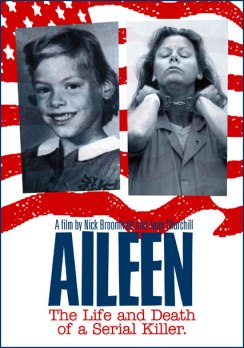 atory documentary that follows Alieen (a convicted serial killer) whilst she waits for her death sentence the be carried out. This documentary includes a lot of montages. A montage is a series of clips/images that are edited together to create a narrative or to inform the audience. Montages in documentaries are usually linked with words that the narrator/characters say, this is to give the audience a clearer a better understanding of what they are saying. For example, in this documentary, at the beginning the filmmaker is talking in a voice over and is stating facts about Alieen and why she is awaiting the electric chair and why she is in prison, whilst he is talking there is a montage of the crime scenes, pictures of Alieen’s mug shot, newspaper articles, videos of the victims families and other things relating to Alieen and her crimes. This has been included so the audience can get a sense of realism and to grip them in to the storyline by showing the real life pictures of the crimes scenes and other things like that. By showing these clips and images, it gives the audience reason to carry on watching the film because they are now interested in the reasoning behind her killing all these ‘innocent’ men and by showing the audience images of the dead victims and newspaper clippings, it makes them understand that this is a life real case and that 7 men were actually killed.
atory documentary that follows Alieen (a convicted serial killer) whilst she waits for her death sentence the be carried out. This documentary includes a lot of montages. A montage is a series of clips/images that are edited together to create a narrative or to inform the audience. Montages in documentaries are usually linked with words that the narrator/characters say, this is to give the audience a clearer a better understanding of what they are saying. For example, in this documentary, at the beginning the filmmaker is talking in a voice over and is stating facts about Alieen and why she is awaiting the electric chair and why she is in prison, whilst he is talking there is a montage of the crime scenes, pictures of Alieen’s mug shot, newspaper articles, videos of the victims families and other things relating to Alieen and her crimes. This has been included so the audience can get a sense of realism and to grip them in to the storyline by showing the real life pictures of the crimes scenes and other things like that. By showing these clips and images, it gives the audience reason to carry on watching the film because they are now interested in the reasoning behind her killing all these ‘innocent’ men and by showing the audience images of the dead victims and newspaper clippings, it makes them understand that this is a life real case and that 7 men were actually killed.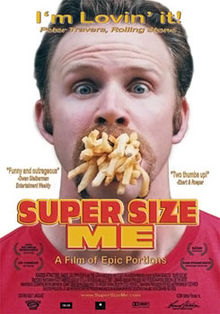 ealth. During this documentary, Morgan eats nothing but McDonalds 3 meals a day for 30 days straight. The film follows him as his body and health changes, the emotional and physical pain he goes through and the medial effects of what McDonalds food can do to you. This documentary is in The Performative Mode. The Performative Mode is a type of documentary that welcomes direct engagement between the filmmaker and the film subject. The filmmaker becomes involved in the events being recorded prehaps participating in something he or she wants to prove. Supersize me fits this mode perfectly. For example, Morgan wants to prove to the audience how bad the effects can be from excessively eating McDonalds food like many Americans already do. To achieve this result, he carries out the experiment himself
ealth. During this documentary, Morgan eats nothing but McDonalds 3 meals a day for 30 days straight. The film follows him as his body and health changes, the emotional and physical pain he goes through and the medial effects of what McDonalds food can do to you. This documentary is in The Performative Mode. The Performative Mode is a type of documentary that welcomes direct engagement between the filmmaker and the film subject. The filmmaker becomes involved in the events being recorded prehaps participating in something he or she wants to prove. Supersize me fits this mode perfectly. For example, Morgan wants to prove to the audience how bad the effects can be from excessively eating McDonalds food like many Americans already do. To achieve this result, he carries out the experiment himself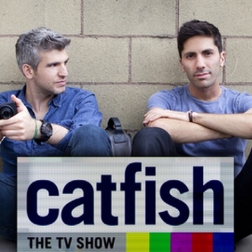 is a reality-based television docu-series that uncovers the truths about online dating. Each episode they will help somebody who has reached out to them via email, the person they are helping will be in an online relationship but will be unsure the person they are talking to is the person they really are. The process is Max and Neev (the two presenters/filmmakers) doing research on the person of interest and digging up the truth and uncovering if they are ‘real’ or a ‘catfish’. This docu-series is made in The Reflexive Mode. The Reflexive Mode is where they acknowledge the constructed nature of documentary and ‘flaunts it’. This mode will convey to people that it is not necessarily truth but a reconstruction of a truth, the audience are aware of editing and blatant dramatisation. Catfish fits perfectly into the reflexive mode. For example, in all of the episodes, at the end/near end of the show there is a meet up between the two people who are in an online relationship and the truth is uncovered as to whether they are a catfish or not, and this scene is always very dramatised. The audience are aware of this dramatisation and the fact that parts/all of the conversation is scripted/fixed even though it is filmed to make it look like they are real life natural events. This is very entertaining to the audience because even though a lot of this scene will be scripted, it is filmed with a hand help camera which makes it look real and there are entertaining events that happen that seem natural even though they aren’t.
is a reality-based television docu-series that uncovers the truths about online dating. Each episode they will help somebody who has reached out to them via email, the person they are helping will be in an online relationship but will be unsure the person they are talking to is the person they really are. The process is Max and Neev (the two presenters/filmmakers) doing research on the person of interest and digging up the truth and uncovering if they are ‘real’ or a ‘catfish’. This docu-series is made in The Reflexive Mode. The Reflexive Mode is where they acknowledge the constructed nature of documentary and ‘flaunts it’. This mode will convey to people that it is not necessarily truth but a reconstruction of a truth, the audience are aware of editing and blatant dramatisation. Catfish fits perfectly into the reflexive mode. For example, in all of the episodes, at the end/near end of the show there is a meet up between the two people who are in an online relationship and the truth is uncovered as to whether they are a catfish or not, and this scene is always very dramatised. The audience are aware of this dramatisation and the fact that parts/all of the conversation is scripted/fixed even though it is filmed to make it look like they are real life natural events. This is very entertaining to the audience because even though a lot of this scene will be scripted, it is filmed with a hand help camera which makes it look real and there are entertaining events that happen that seem natural even though they aren’t.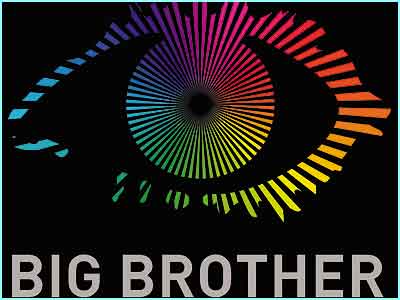
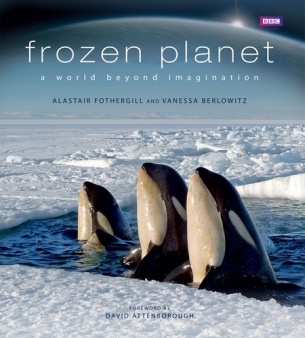 narrating and will talk in a way that will grip their attention, without this narration the audience will have no interest as all they are watching is animals doing their own thing, adding a narrator makes things much more interesting. Another example of how narration effects this show in a great way is when we are watching a fight/a hunt between animals, David Attenborough will talk in an excited manner and will make the scene much more fast-pace and interesting, atmospheric music also helps create a tense scene.
narrating and will talk in a way that will grip their attention, without this narration the audience will have no interest as all they are watching is animals doing their own thing, adding a narrator makes things much more interesting. Another example of how narration effects this show in a great way is when we are watching a fight/a hunt between animals, David Attenborough will talk in an excited manner and will make the scene much more fast-pace and interesting, atmospheric music also helps create a tense scene.